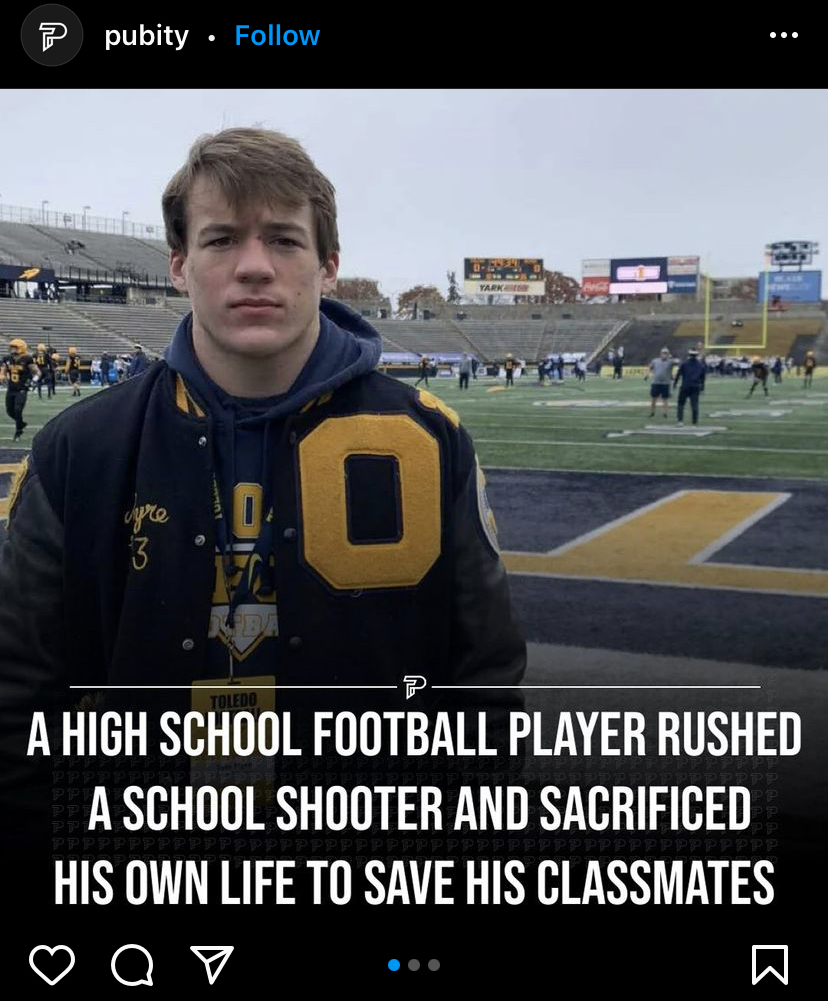Because the news cycle moves so quickly and there is no shortage of horrible, disheartening stories out there, it’s easy to forget that just one month ago—on November 30, 2021—Ethan Crumbley opened fire in his high school, killing four people and injuring seven others.
In the days after the deadly shooting, we saw videos of students hunkering down in classrooms and heard stories from survivors. Flowers, stuffed animals, and candles were left on the school’s entry sign. A candlelight vigil was held at a nearby park. Signs reading “Oxford Strong” started showing up in front of local businesses. GoFundMe pages were created by the dozens to help the victims and their families.
These efforts to manage our collective grief happen so frequently they almost feel trite to me, a kind of performative ritual that must occur each and every time a young person’s life is cut short by gun violence. We soothe ourselves with platitudes and beautiful gestures and find comfort in the kindness of strangers. See, the world isn’t all bad, we whisper. There are still so many good people.
There were also tributes to the four students who died that day: Hana St. Juliana (14), Madisyn Baldwin (17), Tate Myer (16), and Justin Shilling (17). According to eyewitness reports, Tate Myer was killed while trying to disarm Crumbley. Soon after the news was released, a petition was created to rename the school’s stadium in his honor, garnering more than 83,000 signatures in just a few days.



I saw a post on Instagram detailing Myer’s actions and the call to honor his sacrifice, and rather than scroll past or give it a fleeting like or comment, I took screen shots. I was deeply bothered by the post, though I didn’t understand why at the time. The gesture is a kind one for certain. Students and members of the community want to lionize this young man, to remember his actions on that dreadful day. The petition’s organizer, Drake Biggie, said that doing so would allow “his bravery… [to] be remembered forever and passed down through generations.”
I thought back to all the schools I attended as a child (and there were many) as well as the ones where I served as a high school teacher for more than a decade. Each of these campuses had gyms, stadiums, auditoriums, or fields dedicated to someone—a famous graduate, a local celebrity, a benevolent member of the community. But I didn’t know any of them personally. No one I worked or attended those schools with seemed to either. The names on those buildings were nothing more than random collections of letters.
If the petition is successful and the school’s stadium is renamed after Tate Myer, there will be a somber ceremony made to commemorate the change. Speeches will be given, ribbons cut, and balloons released. People will feel as if something good has been accomplished. But in time (and sooner than anyone would expect), his name won’t resonate. People won’t remember who he is or what he did to deserve such recognition. It’s simply the way of things.
Actions like this are an attempt at closure, a way to redeem a loss or “bring about beauty from ashes.” But catharsis prevents real change. When we focus only on closing the loop or helping everyone heal, we lose sight of what caused this trauma in the first place: guns, poor parenting, a lack of mental health services, and good old human cruelty.
What an event like the one that happened at Oxford High School should do is make us righteously furious. It should lead us to “get into good trouble,” as the late John Lewis once said. We shouldn’t permit ourselves to be tranquilized. We should get angry and stay that way. We should protest every single factor that led to a sixteen-year-old boy having to throw himself in front of a gun to save other people.
If we don’t start addressing the elements that lead to school shootings, we’ll simply continue a pointless cycle. A violent act will lead to an investigation, but nothing will come of it. We will mourn both collectively and in the silent chambers of our own hearts only to move on. And a few weeks or months later, it will happen again in somewhere else in the U.S.
Another young man will express his rage with a hail of bullets.
Another child will lay down his or her life to save others.
More children will become statistics instead of college graduates, spouses, and parents.
More candles will be lit and makeshift memorials created.
How many times does it have to happen before we finally stop pacifying ourselves and put our grief to good use?
Thank you, Jamie. Beautifully said.
Glad you enjoyed, Karen! Thanks for leaving a comment.